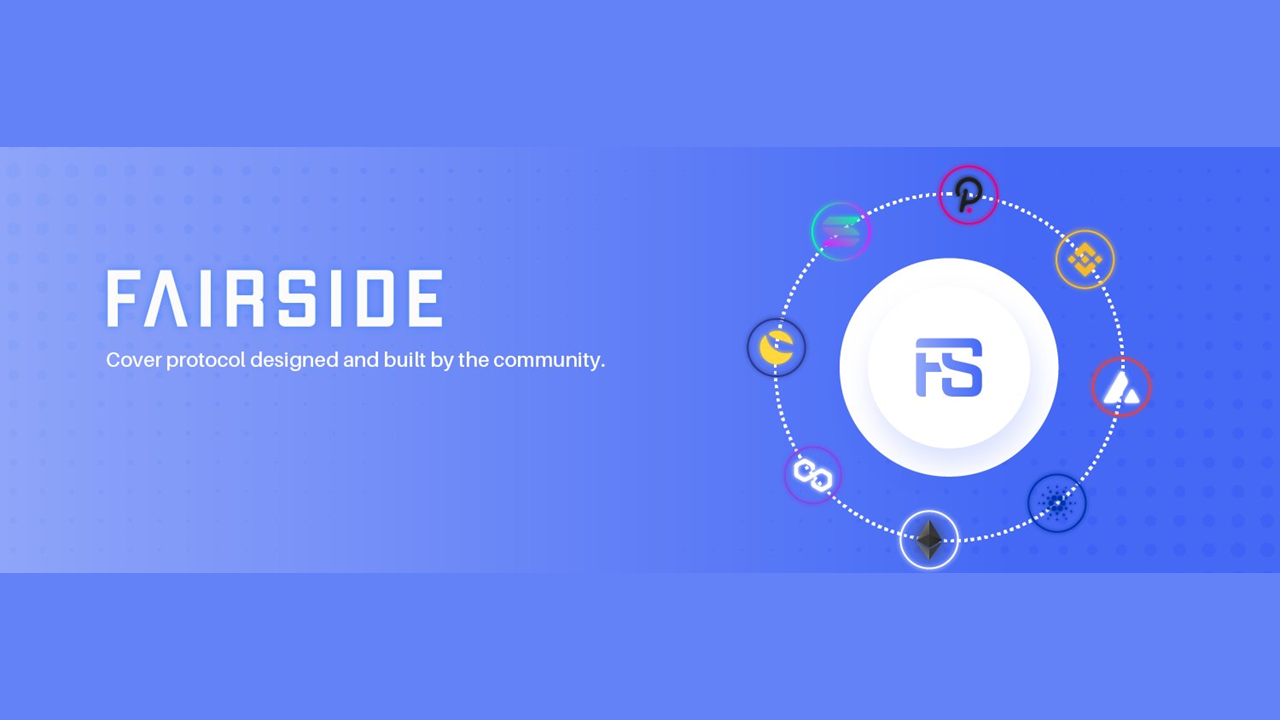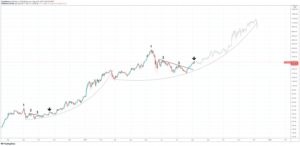
The insurance industry is over two hundred years old and it has evolved into a vital component of the global economy. The demand for insurance has grown by more than 130 percent over the last decade and is now a staggering $5.5 trillion industry. With new businesses and opportunities coming to life, the demand is unlikely to cease. Likewise, one industry where the demand for insurance is growing at a rapid pace is crypto and DeFi.
Despite the rising demand for insurance, today’s fragmented financial infrastructure faces significant challenges. Over 97% of cryptocurrency assets are not protected against unjustified losses due to events like smart contract failure or code vulnerabilities. In contrast to this, users of traditional financial tools enjoy the protection of highly regulated institutions such as the Federal Deposit Insurance Corporation (FDIC).
As a solution to this, FairSide, a cover protocol, is introducing a strategy proven in traditional insurance to all crypto uses.
What is the FairSide Protocol?
FairSide is a next-generation cover primitive powered by its native crypto token FSD. It aims to offer crypto users the same benefits of insurance awarded to traditional finance through its decentralized cost-sharing network. The protocol is working to advance the current insurance processes in crypto to provide much-needed protection for crypto investors.
What’s unique about FairSide is that it decentralizes the conventional insurance business model, thereby distributing the risk and benefits, without depending on anyone’s centralized authority. While other DeFi insurance methods require you to buy separate coverage for each crypto investment, FairSide enables you to protect your crypto investments with a single membership.
As a DAO governed entirely by its members, the network defines exactly the type of loss events that are covered. Currently, popular concerns like smart contract failure, personal wallet exploits, stablecoins pegs, failed business logic, oracle failures, rug pulls, exchange hacks, among other events are being considered by the DAO for coverage types.
How FairSide Covers the Losses?
FairSide covers losses by relying on principles built from within traditional insurance models that have been established over decades. This fundamental approach is applied to a community-based Cost Sharing Network to provide the widest and most fair coverage.
To facilitate this, FairSide has developed a unique model known as Network Staking. Network Staking is a highly capital efficient model designed to lower individual staking risk, increase rewards, expand coverage options and improve the claims process.
Network Staking is a diversified staking model where contributors stake the entire network, not a specific project or pool. This allows the contributors to decouple their risk from any specific project. This low correlation of risk drives the network’s capital efficiency. Capital efficiency is the network’s ability to leverage the use of its assets to safely and securely offer cover. This is arguably the most important aspect of any cover protocol. Network Staking has allowed FairSide to boast a 10x position at product launch. As the network becomes more diverse, the capital efficiency will increase allowing for even greater rewards and a more secure community.
FairSide’s staking model produces a positive effect we call non-permanent staking loss. Normally, what happens with other insurance protocols is that the stakeholder’s assets are permanently liquidated when claims are paid. But, with FairSide, contributors stake ETH in exchange for FSD. The FSD is held in the contributor’s wallet and the number of FSD held does not change as losses are paid. The ETH is bonded to the Capital Pool and used for Cost Share Benefits. The FSD has multiple utility functions but also acts as a sort of synthetic of the Capital Pool. As payouts arise, the value in the Capital Pool will marginally decrease, lowering the token price of FSD slightly. This fractional loss in token price is overcome by network rewards and recapitalization of the pool. Thus, a temporary, non-permanent loss has occurred.
Due to its unique staking model, members-only need a single membership to receive Cost Share Benefits for all approved cover types. Once a cover type has been approved by the DAO, it is automatically included in present and future memberships. Coverage is continuously expanding. Approved cover types are cross-chain, cross-project, and follow the member, not the project.
Network staking allows for contributors to vote fairly since they will not be liquidated if a claim is paid. A community vote is taken on potential claim events as they occur within the crypto industry. These events are not specific to any member(s) of the network, as the vote is taken prior to any known losses of its members. Approved events are open for members to make claims, and no further vote is required by the community. Since the event has already been approved, members only need to provide proof of loss. Once confirmed, the payout is executed via smart contract.
Armed with a new staking approach, FairSide’s utility as a cover protocol for the crypto and DeFi space is unparalleled.
Advantage of using FairSide over other protocols
FairSide aims to grow in tandem with crypto adoption, DeFi, NFTs, and every other area of crypto innovation. Risk diversification is a cornerstone of their business to help build the most robust crypto community while safeguarding their contributors.
Furthermore, FairSide’s capital model is based on classic insurance principles, allowing the cost-sharing potential to surpass the money kept in the Capital Pool. This will maximize contributors’ profits on FSD tokens and outperform all known rivals.
Some of the key advantages of using FairSide include:
- The platform does not have a KYC requirement
- It has a non-permanent loss model
- Its capital-efficient model with low individual risk makes it highly effective
- The single membership plan increases the simplicity and affordability of crypto-related cover
- There is no token lock-up period for contributors or claims assessors
- Implementation of full decentralization at launch
- Contributors and members of the protocol are set to benefit from greater staking rewards, less individual risk, wider coverage, and increased membership.
A Step Toward Securing Crypto Users
Insurance is rarely a straightforward business, and the general perception is lots of paperwork, complex jargon, and a lack of transparency. The problems with the current crypto-insurance landscape extend beyond this with capital inefficiency, instability, unreasonable premiums, and over-complex offerings that discourage users from insuring their investments.
FairSide’s unique model based on network staking seeks to solve these issues. Unlike other DeFi insurance protocols, contributors stake the entire network, not specific projects. This will diversify their risk and enhance capital efficiency.
Since network staking is a diversified approach, coverage is broad-based, eliminating the need for specific project pools. It also opens the consensus voting to a broader population, unlike under traditional staking, where a minimum number of tokens had to be staked as a prerequisite to vote. Since every user is staking the entire network, more users can vote, and true decentralization is achieved.
FairSide aims to emerge as a better alternative to DeFi insurance protocols focusing on the restricted cover offered in DeFi all while providing everyday crypto investors the same protection they would expect in traditional finance. Time will tell whether they will achieve these lofty goals, but Fairside is undoubtedly a project to keep an eye on.
- Adoption
- All
- Allowing
- among
- AREA
- Assets
- build
- business
- business model
- businesses
- buy
- call
- capital
- change
- claims
- code
- coming
- community
- component
- Consensus
- contract
- crypto
- Crypto adoption
- Crypto Industry
- cryptocurrency
- Current
- DAO
- Decentralization
- decentralized
- DeFi
- Demand
- diversification
- economy
- efficiency
- ETH
- Event
- events
- exchange
- Expand
- expanding
- eye
- faces
- Failure
- fair
- fdic
- Federal
- finance
- financial
- financial infrastructure
- follow
- full
- future
- General
- Global
- Global economy
- Goals
- Grow
- Growing
- hacks
- HTTPS
- Increase
- industry
- Infrastructure
- Innovation
- institutions
- insurance
- investment
- Investments
- Investors
- issues
- IT
- Key
- KYC
- launch
- Leverage
- Members
- model
- money
- network
- NFTs
- offer
- Offerings
- open
- opens
- opportunities
- Options
- oracle
- Other
- platform
- pool
- Pools
- Popular
- population
- present
- price
- Product
- project
- projects
- proof
- protect
- protection
- protocol
- Rewards
- Risk
- set
- Share
- smart
- smart contract
- SOLVE
- Space
- Stablecoins
- stake
- Staking
- Strategy
- temporary
- time
- token
- Tokens
- traditional finance
- Transparency
- users
- utility
- value
- Vote
- Voting
- Vulnerabilities
- Wallet
- within
- years












